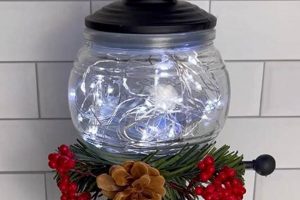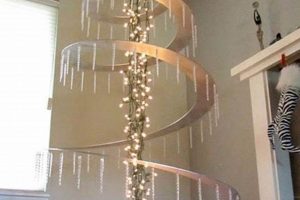The creation of a festive centerpiece using branches adorned with decorative ornaments associated with the spring holiday is a popular crafting activity. This decorative item commonly features eggs, chicks, bunnies, and other symbols of rebirth and renewal, transforming simple branches into a vibrant display.
Employing such a handcrafted decoration introduces a personalized element to seasonal celebrations. The process of creating this item allows for individual expression and adaptation to existing dcor, fostering a sense of accomplishment and enhancing the festive atmosphere within a home. Furthermore, the construction of these displays can be a shared activity, encouraging creativity and bonding among family members.
The following discussion will detail different methods for constructing these celebratory ornaments, highlight various material options for their creation, and offer suggestions for arranging them into visually appealing displays.
Tips for Creating a Celebratory Spring Branch Display
Achieving a visually appealing and stable decorative branch arrangement requires careful consideration. The following tips will aid in the successful construction of such a display.
Tip 1: Branch Selection: Opt for sturdy branches with interesting shapes and varying heights to create visual depth. Consider using branches from forsythia, willow, or birch trees.
Tip 2: Secure Base: Provide a stable base to prevent tipping. A heavy vase filled with sand, gravel, or plaster of Paris can effectively secure the branches.
Tip 3: Ornament Weight: Ensure ornaments are lightweight to avoid weighing down delicate branches. Consider using materials such as felt, paper, or plastic eggs.
Tip 4: Ornament Attachment: Use thin wire, ribbon, or ornament hooks to securely attach the decorations to the branches. Ensure the attachments are discreet and blend with the display.
Tip 5: Color Palette: Establish a cohesive color scheme to create a harmonious visual effect. Consider using pastel colors, natural tones, or a vibrant, contrasting palette.
Tip 6: Layering Ornaments: Distribute ornaments evenly throughout the branches, varying their sizes and shapes. Layering ornaments creates depth and visual interest.
Tip 7: Consider Height and Placement: Position the arrangement in a location that complements its size and style. Avoid placing it in high-traffic areas to minimize the risk of damage.
A well-planned and executed display enhances seasonal celebrations and adds a touch of personalization to home decor. By following these guidelines, a visually appealing and durable arrangement can be achieved.
The next section will explore various design ideas and themes for celebratory branch decorations.
1. Branch Selection
Branch selection is a foundational element in constructing a visually appealing celebratory centerpiece. The type of branch chosen directly influences the overall aesthetic and structural integrity. For instance, sturdy branches from deciduous trees, such as birch or willow, can support heavier ornaments and provide a more robust silhouette. Conversely, more delicate branches, like those from flowering quince, may be better suited for lighter decorations and a more ethereal design. The chosen branch serves as the framework upon which the celebratory theme is built, dictating the scale, form, and inherent style of the finished item.
The practical significance of careful branch selection is evident in its impact on the stability and longevity of the seasonal decor. Branches that are too weak or brittle may break under the weight of the ornaments, resulting in a collapsed display and potential damage. Furthermore, the branch’s natural texture, color, and shape contribute significantly to the overall design. Consider the use of pussy willow, with its soft, tactile catkins, to introduce a subtle yet texturally rich dimension. Similarly, bare branches from a crabapple tree offer a unique, sculptural quality even before the addition of decorations.
In summary, appropriate branch selection is crucial for both the aesthetic and structural success of a decorative spring tree. Understanding the specific characteristics of different branch typestheir strength, shape, and textureallows for the creation of a stable, visually harmonious, and long-lasting display that effectively embodies the celebratory theme. Failure to adequately address this aspect can compromise the entire project, leading to an unsatisfactory and ultimately unstable outcome.
2. Ornament Materials
The selection of ornament materials significantly influences the aesthetic appeal, durability, and overall theme of a handcrafted spring-themed branch display. Material choices dictate not only the visual characteristics of the decorations but also the ease of construction and the suitability of the display for various environments.
- Paper and Cardstock
Paper and cardstock offer versatility and affordability, facilitating the creation of intricate shapes and designs. Examples include paper quilled eggs, origami bunnies, and colorful paper flowers. However, paper-based ornaments are susceptible to moisture damage and may fade over time, limiting their suitability for outdoor display or humid environments.
- Felt and Fabric
Felt and fabric provide a soft, tactile quality and allow for the creation of plush ornaments such as felt chicks, fabric carrots, and embroidered eggs. These materials are durable and can withstand handling, making them suitable for displays in homes with children. However, fabric ornaments may require more advanced crafting skills and can be more time-consuming to produce.
- Wood and Natural Elements
Wood beads, twigs, and dried flowers introduce a natural, rustic aesthetic to the display. Wooden egg ornaments can be painted, stained, or wood-burned with intricate designs. These materials are durable and environmentally friendly. However, wooden ornaments can be heavier than other options, requiring sturdier branches for support, and natural materials may attract insects.
- Plastic and Acrylic
Plastic and acrylic beads, sequins, and pre-made ornaments offer a wide range of colors, shapes, and finishes. Plastic Easter eggs can be readily decorated with paint, glitter, or decoupage techniques. These materials are lightweight, durable, and resistant to moisture. However, plastic ornaments can appear less handcrafted and may not align with a natural or eco-conscious theme.
In conclusion, the strategic selection of ornament materials dictates the visual and tactile qualities of the spring-themed branch display. Considering factors such as durability, ease of construction, environmental impact, and aesthetic suitability is paramount to achieving a cohesive and enduring decorative effect. Furthermore, the chosen material must align with the desired theme, reflecting a traditional, rustic, or modern style, thereby enhancing the overall impact of the creation.
3. Base Stability
Base stability constitutes a critical element in the successful construction and display of any decorative spring branch arrangement. The structural integrity of the base directly affects the overall stability of the arrangement. Inadequate base support precipitates tipping or collapse, compromising the aesthetic appeal and potentially causing damage to the ornaments and surrounding environment. A stable base, conversely, provides a secure foundation, ensuring the arrangement remains upright and visually pleasing.
Real-world examples illustrate the importance of appropriate base selection. A lightweight vase filled solely with water is often insufficient to support the weight of branches adorned with multiple ornaments, leading to instability. Conversely, a heavy ceramic pot filled with sand, gravel, or plaster of Paris provides significantly enhanced stability. The choice of container material, its weight, and the inclusion of stabilizing fill directly influence the arrangement’s ability to withstand external forces such as wind or accidental contact. Furthermore, the base’s aesthetic integration with the overall theme enhances the visual coherence of the display. For example, a rustic wooden container complements a natural, woodland-inspired theme, while a sleek, modern vase aligns with a minimalist design.
In summary, base stability is an indispensable element in the creation and maintenance of any decorative branch arrangement. Prioritizing a robust and aesthetically appropriate base ensures the structural integrity of the display, prevents potential damage, and enhances its overall visual impact. Neglecting this aspect can undermine the entire effort, resulting in an unstable and ultimately unsatisfactory outcome. Careful consideration should, therefore, be given to the selection of a suitable base, considering its weight, material, and aesthetic compatibility with the chosen theme and branch structure.
4. Color Harmony
Color harmony represents a critical design principle in the creation of visually appealing springtime branch decorations. The deliberate selection and arrangement of colors within the display directly influence its aesthetic impact and its ability to evoke the desired seasonal atmosphere. A lack of color harmony results in a jarring or uncoordinated appearance, diminishing the overall effect. Conversely, a well-executed color scheme enhances the decorative items visual appeal and reinforces its thematic association with the season.
Consider, for example, the application of analogous color schemes, utilizing colors that are adjacent on the color wheel, such as yellows, oranges, and greens. This approach fosters a sense of visual unity and tranquility, reflecting the gentle transitions observed in nature during springtime. Another approach involves complementary color schemes, employing colors opposite each other on the color wheel, such as blues and yellows, to create a vibrant and dynamic contrast. The judicious use of a complementary scheme, however, requires careful balancing to prevent visual overload. Furthermore, the incorporation of neutral tones, such as whites, creams, and natural wood colors, provides a visual respite and allows the brighter colors to stand out. An example is the use of pastel-colored eggs against a backdrop of natural birch branches.
The achievement of color harmony in celebratory branch displays necessitates a thoughtful consideration of color theory and practical experimentation. Understanding the relationships between different colors and their emotional associations is essential for creating a visually cohesive and impactful design. Challenges may arise in balancing the desire for vibrant colors with the need for visual harmony. However, the application of color theory principles and the use of neutral tones as visual anchors can mitigate these challenges, resulting in a decorative item that effectively embodies the spirit of the spring season. The careful selection of colors supports and enhances the decorative effort as a whole.
5. Theme Consistency
Theme consistency represents a pivotal design aspect when constructing a decorative springtime branch display. A unified theme ensures the display is not merely a collection of individual ornaments, but rather a cohesive and visually engaging representation of the celebratory season. The presence of thematic discordance diminishes the impact of the entire creation.
- Ornament Style Alignment
A consistent ornamental style prevents visual fragmentation. For example, a display aiming for a rustic theme should feature ornaments crafted from natural materials like wood, burlap, and twine, avoiding elements like shiny plastic or glitter, which would disrupt the aesthetic. This alignment extends to the design of individual ornaments, ensuring that patterns, textures, and shapes complement the overarching theme.
- Color Palette Adherence
Maintaining a consistent color palette strengthens thematic cohesion. A pastel theme would utilize soft shades of pink, blue, yellow, and green, while a more vibrant theme could incorporate bolder hues, but always within a carefully selected range. Diverging from the chosen color palette introduces visual noise and weakens the impact of the intended theme. Even within a theme, balancing color saturation and tone can be important for cohesion.
- Symbolic Representation
The chosen symbols should reinforce the selected theme. A religious theme, for instance, might incorporate crosses, doves, and scriptural elements, while a nature-based theme would feature depictions of animals, plants, and natural landscapes. The inclusion of incongruous symbols, such as overtly commercial characters or unrelated cultural icons, would detract from the thematic unity.
- Base and Container Integration
The base and container supporting the decorative branches should harmonize with the chosen theme. A rustic theme might utilize a weathered wooden bucket or a terracotta pot, while a modern theme could employ a sleek glass vase or a minimalist metal stand. The base serves as the foundation for the entire display, and its integration with the overall theme enhances the cohesive visual narrative.
The successful integration of these facets ensures that the spring-themed branch display effectively communicates a cohesive message. A consistent theme enhances the aesthetic impact, strengthens the symbolic representation, and ultimately elevates the decorative item beyond a mere collection of disparate parts, transforming it into a unified and visually engaging expression of the celebratory spirit.
6. Ornament Placement
Ornament placement is a critical determinant in the visual success of a celebratory branch arrangement. The distribution and arrangement of ornaments directly influence the aesthetic balance, perceived depth, and overall visual impact of the piece. Ill-considered placement leads to visual clutter, imbalance, and a diminishment of the individual ornaments’ beauty. Conversely, thoughtful placement enhances the visual appeal and creates a more engaging and harmonious decorative item.
The strategic distribution of ornaments across the branches is essential. Concentrating ornaments in one area creates a visual imbalance, drawing the eye to that single point and neglecting the rest of the display. A more balanced approach involves distributing ornaments evenly, varying their sizes, shapes, and colors to create visual interest throughout the entire structure. The deliberate placement of larger ornaments lower on the branches provides a sense of grounding, while smaller, lighter ornaments can be positioned higher, creating an illusion of height and airiness. In real-world applications, consider a celebratory branch featuring pastel-colored eggs: scattering these eggs evenly across the branches, while interspersing larger eggs near the base and smaller ones toward the tips, optimizes the visual impact. Furthermore, the orientation of each ornament is crucial; facing ornaments outwards allows them to be fully appreciated, while strategically angling certain ornaments creates depth and dimension.
The significance of ornament placement extends beyond aesthetics, influencing the overall success of the decorated branch display. Proper placement maximizes the impact of the ornaments, fosters visual harmony, and transforms simple branches into a captivating centerpiece. Challenges in achieving effective ornament placement may arise from branch asymmetry or a surplus of ornaments. However, awareness of basic design principles and a willingness to experiment with different arrangements allows for the creation of a balanced, visually pleasing, and thematically appropriate decorative item.
Frequently Asked Questions Regarding Decorative Holiday Branch Displays
The following section addresses common inquiries and misconceptions pertaining to the construction and maintenance of seasonal branch displays, offering clarity and guidance for enthusiasts seeking to create impactful festive decorations.
Question 1: What is the optimal method for preventing a decorated branch arrangement from tipping over?
The most effective method involves utilizing a heavy base, such as a ceramic container filled with sand, gravel, or plaster of Paris. The added weight provides a stable foundation, mitigating the risk of accidental tipping. Additionally, ensuring that the branches are evenly distributed and that heavier ornaments are placed lower on the structure further enhances stability.
Question 2: What type of adhesive is recommended for attaching delicate ornaments to branches without causing damage?
Thin gauge wire, craft twine, or clear ornament hooks are recommended for attaching delicate ornaments. These methods minimize the risk of damage to both the ornaments and the branches, while providing a secure and unobtrusive attachment. Hot glue, while effective, can potentially damage delicate materials and is generally not advisable.
Question 3: How does one effectively clean or maintain a branch display to prevent dust accumulation?
Regular dusting with a soft brush or microfiber cloth is the most effective method for preventing dust accumulation. Alternatively, a gentle stream of compressed air can be used to dislodge dust from hard-to-reach areas. Avoid using water or harsh cleaning agents, as these can damage the branches and ornaments.
Question 4: Is it possible to use live branches for a decorative display, and if so, what are the considerations?
Live branches can be utilized, but require careful consideration of their water source and longevity. Placing cut branches in a water-filled container will prolong their lifespan, but the water must be changed regularly to prevent bacterial growth. The weight of the water-filled container must also be factored into the base stability.
Question 5: How can one effectively store a decorated branch display for future use, ensuring the ornaments remain intact?
Careful storage is essential for preserving the integrity of the decorative display. The branches should be gently disassembled, and the ornaments individually wrapped in tissue paper or bubble wrap. Store the ornaments and branches in a sturdy container in a cool, dry location away from direct sunlight to prevent fading or damage.
Question 6: What is the recommended method for disposing of branches and ornaments after the holiday season?
Branches can be composted or disposed of according to local regulations. Ornaments made from recyclable materials, such as paper or plastic, can be recycled. Non-recyclable ornaments should be disposed of responsibly. Avoid discarding branches or ornaments in natural areas, as they can disrupt the ecosystem.
This section provided answers to the most frequently asked questions. These answers will help to build the display with the maximum result.
The subsequent section will present different design options for celebratory springtime branch decorations.
DIY Easter Tree
The preceding discussion has explored multiple facets of the DIY Easter tree, emphasizing the critical components that contribute to its aesthetic and structural integrity. Branch selection, ornament materials, base stability, color harmony, thematic consistency, and ornament placement have all been identified as essential elements requiring careful consideration. The successful integration of these elements culminates in a visually compelling and structurally sound celebratory decoration.
The creation of a personalized spring branch display offers an opportunity for creative expression and seasonal celebration. By adhering to the principles outlined herein, individuals can craft a decorative piece that reflects their unique aesthetic and enhances the festive atmosphere. Continued exploration of design techniques and material options will further refine the art of decorative branch arrangement, ensuring its enduring appeal and significance in seasonal celebrations.







